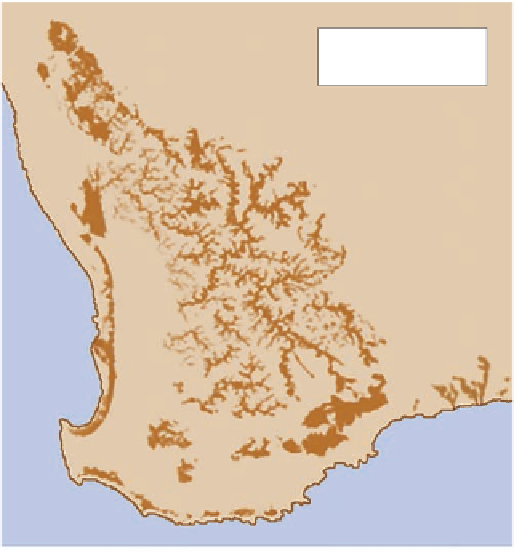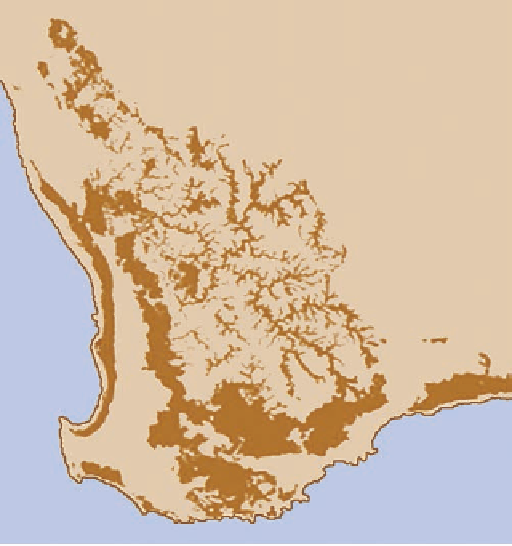Geoscience Reference
In-Depth Information
soils, especially since water rapidly evaporates in the semi-arid
to arid climate. A third factor is that much of the groundwater
in Australia is saline—in some cases, as much as the ocean that
surrounds the continent. This natural groundwater salinity is a
result of the gradual salinization of Australia over tens of mil-
lions of years and the slow, persistent downward movement of
salt into underlying aquifers.
Given the natural salinity of Australia, the potential for soil
salinization due to agriculture is extremely high. Significant ar-
eas of the country are already being affected by the problem
(Figure 20.21). In the Murray-Darling River basin, salinization
occurs because irrigation is increasing soil salinity in a manner
very similar to what we discussed in the San Joaquin Valley.
The largest areas of dryland salinity are in the wheat belt of
Western Australia, where salinization is largely related to the
clearing of native vegetation and the associated rise of the water
table. In this context, salts are either accumulating in depres-
sions or are wicked up from the shallow water table.
The real and potential costs of soil salinization in Australia
are staggering. About 5.7 million hectares (14 million acres),
or approximately 16% of the agricultural area, are currently at
risk. The reduced or lost crop yields from this large area have
cost farmers about $1.3 billion Australian dollars (~$800 mil-
lion U.S.) in lost income. Soil salinization is also posing risks
to urban and rural infrastructure (because it deteriorates iron
and concrete), as well as the health of stream ecosystems and
wetlands.
The problem of soil salinization has a very high profile
in Australia and is a major source of concern. Unfortunately,
the situation is expected to become even worse in the future.
A good place to see the likely future outcome is in the wheat
belt in Western Australia. At present, about 3.5 million hectares
(~8.6 million acres) of the region are at risk of eventual soil sali-
nization. At current rates of salinization, the amount of land that
will be affected is expected to double by 2050 (Figure 20.22).
In the country as a whole, the amount of land salinized may
reach 17 million hectares (42 million hectares).
0
50
100 km
0
50
100 mi
N
Indian Ocean
(a)
0
50
100 km
0
50
100 mi
N
N
Indian Ocean
Salinized soils
0
250
500 km
(b)
0
200
400 mi
Figure 20.22 Dryland salinity in southwestern Australia.
(a) Map showing the extent of dryland salinity in 2000. (b) Map
showing area expected to be at risk for salinization by 2050.
(
Source
: Commonwealth of Australia.)
Figure 20.21 Australia soil salinization.
Map of areas in
Australia where soil salinization is a problem. (
Source
:
Common-
wealth of Australia.)































































































































